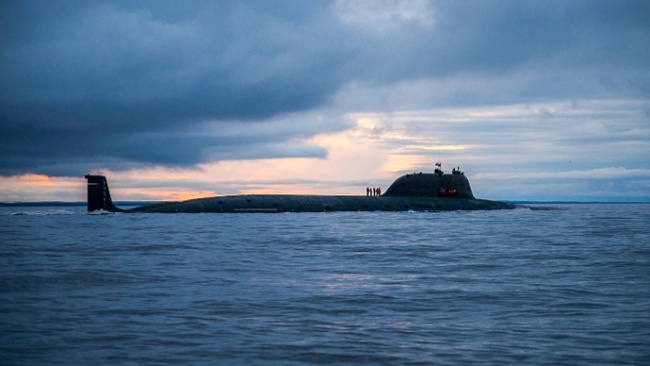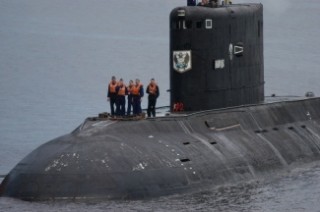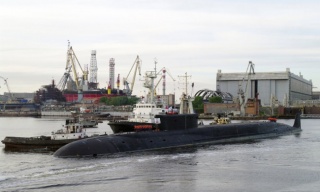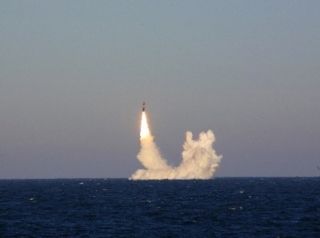
Norway’s environmental prosecutor fines Equinor a record amount following Bellona complaint
Økokrim, Norway’s authority for investigating and prosecuting economic and environmental crime, has imposed a record fine on Equinor following a comp...
News

Publish date: September 12, 2014
News
The newest of Russia’s multi-purpose nuclear submarines, the Severodvinsk, has finally been commissioned for full service after completing deep sea diving tests in the White Sea it began in June, and will be deployed in the Barents Sea, the latest of a series of Arctic military overtures overseen by Vladimir Putin.
Earlier this month, Putin in a speech to the Seliger patriotic summer camp a great show of the importance of Russia asserting its dominance in the Arctic.
“It is our task to devote more attention to issues of developing the Arctic and to fortify our position there,” he told a group of young patriots on September 3.
He emphasized the Arctic was a preeminent transportation zone, via the Northern Sea Route that rivals the Suez Canal, and predicted the Arctic route would become “a powerful competitor to existing transport arteries.”
But the uber-militaristic rhetoric that’s characteristic of Putin these days took center stage.

“The Arctic plays a very important role from the point of view of assuring security,” he said. “Because of that, first strike American nuclear submarines are concentrated there not far from the coast of Norway – the flight time of their missiles to Moscow is 15 to 15 minutes. But a significant portion of our naval submarine forces are there too.”
The full deployment of the Severodvinsk, whose construction was the longest, most expensive build of any sub produced by Russia or the Soviet Union ever at $2.2 billion, is a centerpiece of the roll out of the fourth generation Yasen Class sub line. Billed as multi-purpose, its nuclear missile reach is from 1,500 kilometers to 5,000 kilometers, somewhat fogging its distinction from ballistic missile submarines.

Goodbye, Cooperative Threat Reduction
In all the production Russia’s two new sub classes, the Yasen and Borei, which is considered third generation, will financially dwarf US financed expenditures after the Cold War to help Russia rid itself of its intercontinental ballistic missile submarine fleet, meaning Cooperative Threat Reduction efforts have, after two decades, essentially come to naught, said Bellona’s managing director and nuclear physicist, Nils Bøhmer.
“The building of new nuclear submarines shows that the Russian Navy has funding, and that they should use a larger proportion of that money on cleaning up its still evident Cold War mess,” said Bøhmer.
The next Yasen Class sub, the Kazan, is expected to exceed the price tag of the Severodvinsk at $2.9 billion.
The efforts of the United States to help rid the Soviet fleet of its ballistic missiles under the Cooperative Threat Reduction program’s annual Defense Department investment of $500,000 added up to, for comparison, some $6 million dollars by the time Russia decided to scrap the agreement in June 2013 – or 0.2 percent of the bill for the next Yasen Class sub.
Flurry of missile tests – some 40 percent hit targets
Reports of the Severdvinsk’s full commissioning on Friday, carried on the Murmansk-based b-port news portal (in Russian), follow a week of frenetic Russian naval activity in which naval officials trumpeted the success of Bulava-type missile test-firings from submarines in the White Sea.

The missile, fired from the Arctic sea area to a test ground on the Far East Peninsula of Kamchatka Wednesday marked the first successful launch of the Bulava from the Yury Monomakh, of he new Borei Class submarine.
It took the Russian Navy long enough to hit its target. At least eight of the 20 Bulava tests have failed, including one earlier this month, Radio Liberty reported. A September 2013 Bulava trial from the Alexandr Nevsky, another Borei Class sub, failed so woefully it sparked an investigation, which concluded the misfire was the result of production flaws.
Bellona’s Bøhmer said the success of the test was a stroke of luck, and that the frantic missile testing that’s been in evidence in the Arctic area could lead to a very serious accident.
“Luckily this test was a success, but if we see that they’ve test fired some 20 missiles, their success rate is about 40 percent,” he said. “The worst case scenario is that he missile explodes inside the submarine in the course of an unsuccessful test, and this could happen during any of the stream of tests the Russian Navy has promised it will perform this year.”
The Barents Observer news portal, based in Kirkenes, Norway, reported that the number of failed Bulava tests could be even more abysmal than what has been reported.
The Bulava missile system tests began aboard the 40-year-old Typhoon Class sub, the Dmitry Donskoy, the world’s longest submarine, in 2004, the Barents Observer reported. The elderly vessel was the only one conduction tests on the system until the Russian navy began trying in 2011 to hit its target from the Yury Dolgoruky, the first Borei class sub to roll off the Sevmash shipyard’s assembly line.

Like the Severodvinsk, the Yury Dolgoruky was another mammoth, decade-plus construction money pit. It’s commissioning was attended by Putin himself.
According to publicized Russian naval plans, the completion of the eight Borei Class subs is slated for 2020. Seven more Yasen class submarines are also expected to be built in addition to the Severodvinsk, also by 2020.

Økokrim, Norway’s authority for investigating and prosecuting economic and environmental crime, has imposed a record fine on Equinor following a comp...

Our op-ed originally appeared in The Moscow Times. For more than three decades, Russia has been burdened with the remains of the Soviet ...

The United Nation’s COP30 global climate negotiations in Belém, Brazil ended this weekend with a watered-down resolution that failed to halt deforest...

For more than a week now — beginning September 23 — the Zaporizhzhia Nuclear Power Plant (ZNPP) has remained disconnected from Ukraine’s national pow...